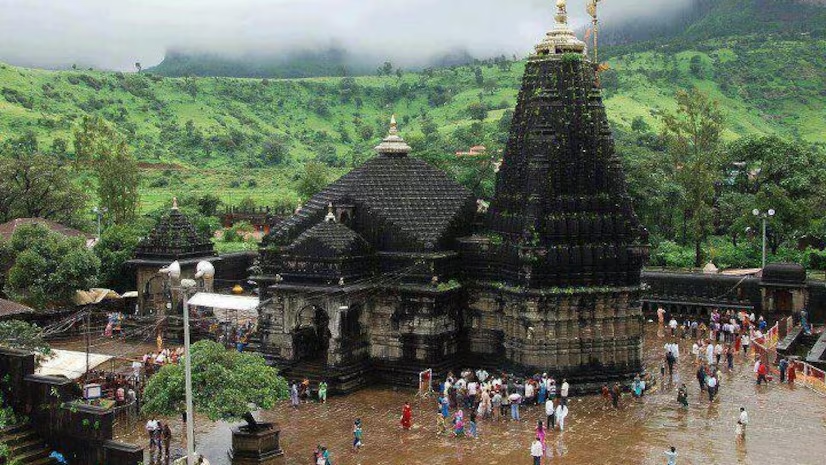Rishikesh, also known as the “Gateway to the Gods,” is a holy city located in the foothills of the Himalayas in Uttarakhand, India. It is a popular pilgrimage destination for Hindus and a popular tourist destination for people from all over the world. Rishikesh is home to many temples, ashrams, and yoga centers. It is also a popular place for adventure activities such as white-water rafting, bungee jumping, and camping.
In this blog, we will take a look at 10 of the best temples to visit in Rishikesh. We will provide you with information on the history, architecture, and significance of each temple. We will also tell you about the best time to visit each temple and how to get there.
1. Trimbakeshwar Temple

Trimbakeshwar Temple is one of the most important temples in Rishikesh. It is dedicated to Lord Shiva and is one of the 12 Jyotirlingas in India. The temple is located on the banks of the Ganges River and is surrounded by beautiful gardens. The main attraction of the temple is the lingam, which is believed to be self-manifested.
History
The history of Trimbakeshwar Temple is not fully known, but it is believed to have been built around the 8th century. The temple was renovated in the 18th century by the Maratha ruler Peshwa Bajirao II.
Architecture
Trimbakeshwar Temple is a beautiful example of North Indian temple architecture. The temple is made of stone and is decorated with intricate carvings. The main entrance of the temple is a tall gopuram, which is a typical feature of South Indian temples. The inner sanctum of the temple houses the lingam, which is surrounded by 12 smaller lingams representing the 12 Jyotirlingas.
Significance
Trimbakeshwar Temple is a very important pilgrimage site for Hindus. It is believed that bathing in the Ganges River at Trimbakeshwar can cure all diseases. The temple is also a popular place for performing puja and other religious rituals.
Best Time to Visit
The best time to visit Trimbakeshwar Temple is during the months of October to March, when the weather is pleasant. The temple is also crowded during the Kumbh Mela, which is a religious festival that takes place every 12 years.
How to Get There
Trimbakeshwar Temple is located about 2 km from Rishikesh city center. You can reach the temple by taxi, auto-rickshaw, or bus.
2. Lakshman Jhula
Lakshman Jhula is a suspension bridge across the Ganges River in Rishikesh. It is named after Lord Lakshman, who is believed to have crossed the river at this point. Lakshman Jhula is a popular tourist spot and is known for its beautiful views of the Ganges River and the surrounding mountains.
History
Lakshman Jhula was built in 1939 by the British. The bridge was damaged during the 2013 Kedarnath floods and was rebuilt in 2014.
Architecture
Lakshman Jhula is a suspension bridge made of steel cables. The bridge is 450 meters long and is 70 meters high. The bridge is decorated with colorful flags and lights.
Significance
Lakshman Jhula is not a religious site, but it is a popular tourist spot. The bridge is a great place to enjoy the views of the Ganges River and the surrounding mountains. Lakshman Jhula is also a popular place for adventure activities such as bungee jumping and zip-lining.
Best Time to Visit
The best time to visit Lakshman Jhula is during the months of October to March, when the weather is pleasant. The bridge is also crowded during the Kumbh Mela.
How to Get There
Lakshman Jhula is located about 2 km from Rishikesh city center. You can reach the bridge by taxi, auto-rickshaw, or bus.
3. Ram Jhula
Ram Jhula is another suspension bridge across the Ganges River in Rishikesh. It is named after Lord Ram, who is believed to have crossed the river at this point. Ram Jhula is a popular tourist spot and is known for its beautiful views of the Ganges River and the surrounding mountains.
History
Ram Jhula was built in 1986. The bridge was damaged during the 2013 Kedarnath floods and was rebuilt in 2014.
Architecture
Ram Jhula is a suspension bridge made of steel cables. The bridge is 450 meters long and is 70 meters high. The bridge is decorated with colorful flags and lights.
Significance
Ram Jhula is not a religious site, but it is a popular tourist spot. The bridge is a great place to enjoy the views of the Ganges River and the surrounding mountains. Ram Jhula is also a popular place for adventure activities such as bungee jumping and zip-lining.
Best Time to Visit
The best time to visit Ram Jhula is during the months of October to March, when the weather is pleasant. The bridge is also crowded during the Kumbh Mela.
How to Get There
Ram Jhula is located about 2 km from Rishikesh city center. You can reach the bridge by taxi, auto-rickshaw, or bus.
4. Bharat Mandir
Bharat Mandir is a temple dedicated to Lord Vishnu. It is located on the banks of the Ganges River and is surrounded by beautiful gardens. The main attraction of the temple is the idol of Lord Vishnu, which is believed to be self-manifested.
History
The history of Bharat Mandir is not fully known, but it is believed to have been built around the 18th century. The temple was renovated in the 19th century.
Architecture
Bharat Mandir is a beautiful example of North Indian temple architecture. The temple is made of stone and is decorated with intricate carvings. The main entrance of the temple is a tall gopuram. The inner sanctum of the temple houses the idol of Lord Vishnu, which is surrounded by the idols of his consorts, Lakshmi and Saraswati.
Significance
Bharat Mandir is a very important pilgrimage site for Hindus. It is believed that bathing in the Ganges River at Bharat Mandir can cure all diseases. The temple is also a popular place for performing puja and other religious rituals.
Best Time to Visit
The best time to visit Bharat Mandir is during the months of October to March, when the weather is pleasant. The temple is also crowded during the Kumbh Mela.
How to Get There
Bharat Mandir is located about 1 km from Rishikesh city center. You can reach the temple by taxi, auto-rickshaw, or bus.
5. Parmarth Niketan Ashram
Parmarth Niketan Ashram is a yoga and meditation center located on the banks of the Ganges River in Rishikesh. The ashram is home to many spiritual leaders and is a popular place for people from all over the world to learn about yoga and meditation.
History
Parmarth Niketan Ashram was founded in 1974 by Swami Dayananda Saraswati. The ashram has grown significantly since its founding and is now one of the most well-known yoga and meditation centers in India.
Architecture
Parmarth Niketan Ashram is a large complex of buildings that are spread out over several acres of land. The ashram has a beautiful garden and a view of the Ganges River. The main building of the ashram houses the meditation hall, the yoga studio, and the library.
Significance
Parmarth Niketan Ashram is not a religious site, but it is a popular place for people who are interested in yoga and meditation. The ashram offers a variety of programs, including yoga classes, meditation workshops, and spiritual discourses.
Best Time to Visit
The best time to visit Parmarth Niketan Ashram is during the months of October to March, when the weather is pleasant. The ashram is also crowded during the Kumbh Mela.
How to Get There
Parmarth Niketan Ashram is located about 2 km from Rishikesh city center. You can reach the ashram by taxi, auto-rickshaw, or bus.
6. Gita Bhawan
Gita Bhawan is a temple dedicated to the Bhagavad Gita, a sacred Hindu scripture. The temple is located on the banks of the Ganges River and is surrounded by beautiful gardens. The main attraction of the temple is the Bhagavad Gita library, which houses a large collection of manuscripts and translations of the Bhagavad Gita.
History
Gita Bhawan was founded in 1951. The temple was damaged during the 2013 Kedarnath floods and was rebuilt in 2014.
Architecture
Gita Bhawan is a beautiful example of North Indian temple architecture. The temple is made of stone and is decorated with intricate carvings. The main entrance of the temple is a tall gopuram. The inner sanctum of the temple houses the Bhagavad Gita manuscripts.
Significance
Gita Bhawan is a very important pilgrimage site for Hindus. It is believed that reading the Bhagavad Gita at Gita Bhawan can bring peace
7. Neelkanth Mahadev Temple
Neelkanth Mahadev Temple is a temple dedicated to Lord Shiva. It is located on the Neelkanth Parvat, which is a hill about 10 km from Rishikesh. The temple is a popular pilgrimage site and is known for its beautiful views of the Ganges River and the surrounding mountains.
History
Neelkanth Mahadev Temple is believed to have been built around the 8th century. The temple was renovated in the 18th century by the Maratha ruler Peshwa Bajirao II.
Architecture
Neelkanth Mahadev Temple is a beautiful example of North Indian temple architecture. The temple is made of stone and is decorated with intricate carvings. The main entrance of the temple is a tall gopuram. The inner sanctum of the temple houses the lingam, which is believed to be self-manifested.
Significance
Neelkanth Mahadev Temple is a very important pilgrimage site for Hindus. It is believed that Lord Shiva drank poison from the ocean to save the world from destruction. The temple is also a popular place for performing puja and other religious rituals.
Best Time to Visit
The best time to visit Neelkanth Mahadev Temple is during the months of October to March, when the weather is pleasant. The temple is also crowded during the Kumbh Mela.
How to Get There
Neelkanth Mahadev Temple is located about 10 km from Rishikesh city center. You can reach the temple by taxi, auto-rickshaw, or bus.
8. Rajaji National Park
Rajaji National Park is a national park located in the foothills of the Himalayas in Uttarakhand. The park is home to a variety of wildlife, including tigers, elephants, leopards, and deer. Rajaji National Park is a popular place for wildlife safaris and trekking.
History
Rajaji National Park was established in 1983. The park is named after Rajaji, a prominent Indian statesman.
Architecture
There are no temples or other architectural structures in Rajaji National Park. However, the park is a beautiful place to enjoy the natural beauty of the Himalayas.
Significance
Rajaji National Park is an important wildlife sanctuary. The park is home to a variety of endangered species. Rajaji National Park is also a popular place for trekking and other outdoor activities.
Best Time to Visit
The best time to visit Rajaji National Park is during the months of November to March, when the weather is pleasant. The park is also crowded during the peak tourist season.
How to Get There
Rajaji National Park is located about 20 km from Rishikesh city center. You can reach the park by taxi, auto-rickshaw, or bus.
9. Ved Vyas Ashram
Ved Vyas Ashram is an ashram located on the banks of the Ganges River in Rishikesh. The ashram is believed to be the birthplace of the sage Ved Vyas, who is considered to be the compiler of the Vedas, the sacred Hindu scriptures.
History
Ved Vyas Ashram is believed to have been founded by sage Ved Vyas himself. The ashram is a popular pilgrimage site and is known for its beautiful views of the Ganges River and the surrounding mountains.
Architecture
Ved Vyas Ashram is a simple ashram with a few buildings. The main building of the ashram houses the Ved Vyas shrine. The ashram is surrounded by beautiful gardens.
Significance
Ved Vyas Ashram is a very important pilgrimage site for Hindus. It is believed that visiting Ved Vyas Ashram can bring peace and spiritual enlightenment. The ashram is also a popular place for performing puja and other religious rituals.
Best Time to Visit
The best time to visit Ved Vyas Ashram is during the months of October to March, when the weather is pleasant. The ashram is also crowded during the Kumbh Mela.
How to Get There
Ved Vyas Ashram is located about 1 km from Rishikesh city center. You can reach the ashram by taxi, auto-rickshaw, or bus.
10. Shivananda Ashram
Shivananda Ashram is a yoga and meditation center located on the banks of the Ganges River in Rishikesh. The ashram was founded by Swami Shivananda Saraswati in 1936. Shivananda Ashram is one of the most well-known yoga and meditation centers in India.
History
Shivananda Ashram was founded in 1936 by Swami Shivananda Saraswati. The ashram has grown significantly since its founding and is now a large complex of buildings.
Architecture
Shivananda Ashram is a large complex of buildings that are spread out over several acres of land. The ashram has a beautiful garden and a view of the Ganges River. The main building of the ashram houses the meditation hall, the yoga studio, and the library.
Significance
Shivananda Ashram is not a religious site, but it is a popular place for people who are interested in yoga and meditation. The ashram offers a variety of programs, including yoga classes, meditation workshops, and spiritual discourses.
Best Time to Visit
The best time to visit Shivananda Ashram is during the months of October to March, when the weather is pleasant. The ashram is also crowded during the Kumbh Mela.
How to Get There
Shivananda Ashram is located about 2 km from Rishikesh city center. You can reach the ashram by taxi, auto-rickshaw, or bus.








